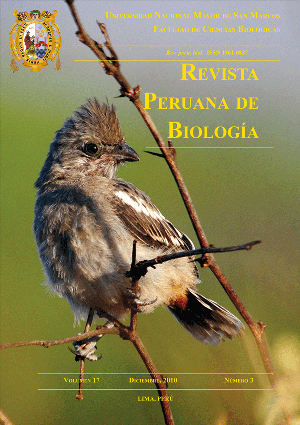Responses of bats to forest fragmentation at Pozuzo, Peru
DOI:
https://doi.org/10.15381/rpb.v17i3.2Keywords:
bats, fragmentation, tropical forests, Southwestern Amazon subandean evergreen forest, humanmodified landscapes, conservation, Pozuzo, Peru.Abstract
Forest fragmentation and deforestation are among the major threats to Peruvian bats conservation. Unfortunately,information about the effects of these threats above 500 m elevation is lacking. In this study, I assessed
bat responses to fragmentation in Pozuzo (Pasco) at a landscape scale approach. I evaluate two hypotheses
regarding the role of bats as indicators of habitat disturbance. The first prediction says that landscapes highly
disturbed will show higher abundances of habitat generalist species such as frugivorous bats belonging to the
subfamilies Stenodermatinae and Carollinae. The second prediction regards that landscapes with greater forest
cover will show higher abundance of habitat specialist species such as animalivorous bat species belonging
to the subfamily Phyllostominae, a guild sensitive to forest disturbance. I found evidence supporting the animalivorous
hypothesis but it was partial to the frugivorous hypothesis. This study highlights the importance of
forest fragments to bat conservation in human-modified landscapes.
Downloads
Downloads
Published
Issue
Section
License
Copyright (c) 2010 José Luis Mena

This work is licensed under a Creative Commons Attribution-NonCommercial-ShareAlike 4.0 International License.
AUTHORS RETAIN THEIR RIGHTS:
a. Authors retain their trade mark rights and patent, and also on any process or procedure described in the article.
b. Authors retain their right to share, copy, distribute, perform and publicly communicate their article (eg, to place their article in an institutional repository or publish it in a book), with an acknowledgment of its initial publication in the Revista Peruana de Biologia.
c. Authors retain theirs right to make a subsequent publication of their work, to use the article or any part thereof (eg a compilation of his papers, lecture notes, thesis, or a book), always indicating its initial publication in the Revista Peruana de Biologia (the originator of the work, journal, volume, number and date).






